Numerical Analysis of Electric Field Characteristics and Interfacial Pressure of HVDC XLPE Cable Joint Considering Load Cycles
Abstract
:1. Introduction
2. Simulation Model
2.1. Thermal Electrical Model
2.2. Thermal Mechanical Stress Model
3. Model Geometry and Simulation Conditions
3.1. Cable Joint Geometry
3.2. Simulation Conditions
- 24 h load cycles consist of at least 8 h of heating followed by at least 16 h of natural cooling.
- During at least the last 2 h of the heating period, a conductor temperature is maintained above the maximum conductor operating temperature and a temperature drop across the insulation is higher than the maximum temperature difference.
- Depending on the type of HVDC system, eight or twelve “24-h” load cycles are performed at the test voltage.
4. Results
4.1. Thermal Simulation Results
4.2. Electrical Simulation Results
4.2.1. Electric Field Distribution in the Cable Joint According to the Load Cycles
4.2.2. Changes in Electric Field at Specific Locations and Interfaces
4.3. Mechanical Stress Simulation Results
4.3.1. Mechanical Stress Distribution in the Cable Joint According to the Load Cycles
4.3.2. Changes in Radial Stress at Specific Locations and Interfaces
5. Conclusions
- Due to the difference in conductivity between XLPE and SiR, most of the electric field is concentrated on the cable insulation layer.
- During the heating period, the electric field inversion was observed in which the electric field concentration gradually moved to the outer XLPE.
- During the cooling period of 16 h after the heating period, changes in the electric field strength of 44% at the inner semicon/XLPE interface and 20% at the XLPE/SiR interface were confirmed.
- Radial and hoop stress increased the most at the XLPE/SiR interface and at the inner semicon/XLPE interface, respectively.
- During the cooling cycle, the electric field strength at the inner semicon/XLPE interface increased and the radial stress decreased.
- As a result, this behavior of the electric field and the radial stress can decrease the dielectric strength of the cable joint.
- In conclusion, it is important to ensure sufficient initial pressure so that the dielectric strength at the interface does not decrease, even if there is a loss of interface pressure due to temperature fluctuations.
Author Contributions
Funding
Institutional Review Board Statement
Informed Consent Statement
Data Availability Statement
Conflicts of Interest
References
- Andersen, B. HVDC transmission-opportunities and challenges. In Proceedings of the 8th IEE International Conference on AC and DC Power Transmission (ACDC 2006), London, UK, 28–31 March 2006; pp. 24–29. [Google Scholar]
- Arrillaga, J.; Arrillaga, J. High Voltage Direct Current Transmission; Iet: London, UK, 1998; Volume 29. [Google Scholar]
- Meah, K.; Ula, S. Comparative evaluation of HVDC and HVAC transmission systems. In Proceedings of the 2007 IEEE Power Engineering Society General Meeting, Tampa, FL, USA, 24–28 June 2007; pp. 1–5. [Google Scholar]
- Rudervall, R.; Charpentier, J.; Sharma, R. High voltage direct current (HVDC) transmission systems technology review paper. Energy Week 2000, 2000, 1–19. [Google Scholar]
- Alassi, A.; Bañales, S.; Ellabban, O.; Adam, G.; MacIver, C. HVDC transmission: Technology review, market trends and future outlook. Renew. Sustain. Energy Rev. 2019, 112, 530–554. [Google Scholar] [CrossRef]
- Ardelean, M.; Minnebo, P. HVDC Submarine Power Cables in the World: State-of-the-Art Knowledge; Office of the European Union: Luxembourg, 2015. [Google Scholar]
- Valenza, D.; Cipollini, G. HVDC submarine power cable systems-state of the art and future developments. In Proceedings of the the 1995 International Conference on Energy Management and Power Delivery EMPD’95, Singapore, 21–23 November 1995; pp. 283–287. [Google Scholar]
- Ghorbani, H.; Jeroense, M.; Olsson, C.-O.; Saltzer, M. HVDC cable systems—Highlighting extruded technology. IEEE Trans. Power Deliv. 2013, 29, 414–421. [Google Scholar] [CrossRef]
- Mazzanti, G.; Castellon, J.; Chen, G.; Fothergill, J.; Fu, M.; Hozumi, N.; Lee, J.; Li, J.; Marzinotto, M.; Mauseth, F. The insulation of HVDC extruded cable system joints. Part 1: Review of materials, design and testing procedures. IEEE Trans. Dielectr. Electr. Insul. 2019, 26, 964–972. [Google Scholar] [CrossRef]
- CIGRÉ, J.T.F. 21/15, Interfaces in Accessories for Extruded HV and EHV Cables; Technical Brochure; Springer: Berlin/Heidelberg, Germany, 2002; p. 210. [Google Scholar]
- Dang, C.; Fournier, D. Dielectric performance of interfaces in premolded cable joints. IEEE Trans. Power Deliv. 1997, 12, 29–32. [Google Scholar] [CrossRef]
- Fournier, D.; Lamarre, L. Effect of pressure and length on interfacial breakdown between two dielectric surfaces. In Proceedings of the Conference Record of the 1992 IEEE International Symposium on Electrical Insulation, Baltimore, MD, USA, 07–10 June 1992; pp. 270–272. [Google Scholar]
- Du, B.; Gu, L. Effects of interfacial pressure on tracking failure at XLPE cable joint by analyzing discharge light distribution. In Proceedings of the 2010 10th IEEE International Conference on Solid Dielectrics, Potsdam, Germany, 4–9 July 2010; pp. 1–4. [Google Scholar]
- Du, B.; Gu, L.; Zhang, X.; Zhu, X. Fundamental research on dielectric breakdown between XLPE and silicon rubber interface in HV cable joint. In Proceedings of the 2009 IEEE 9th International Conference on the Properties and Applications of Dielectric Materials, Harbin, China, 19–23 July 2009; pp. 97–100. [Google Scholar]
- Kantar, E.; Ildstad, E.; Hvidsten, S. Effect of material elasticity on the longitudinal AC breakdown strength of solid-solid interfaces. IEEE Trans. Dielectr. Electr. Insul. 2019, 26, 655–663. [Google Scholar] [CrossRef]
- Yoshida, S.; Tan, M.; Yagi, S.; Seo, S.; Isaka, M. Development of prefabricated type joint for 275 kV XLPE cable. In Proceedings of the IEEE international symposium on electrical insulation, Toronto, ON, Canada, 3–6 June 1990; pp. 290–295. [Google Scholar]
- Illias, H.; Chen, G.; Lewin, P.L. Modeling of partial discharge activity in spherical cavities within a dielectric material. IEEE Electr. Insul. Mag. 2011, 27, 38–45. [Google Scholar] [CrossRef]
- Denholm, P.; Ela, E.; Kirby, B.; Milligan, M. Role of Energy Storage with Renewable Electricity Generation; National Renewable Energy Lab.(NREL): Golden, CO, USA, 2010. [Google Scholar]
- Sinden, G. Characteristics of the UK wind resource: Long-term patterns and relationship to electricity demand. Energy Policy 2007, 35, 112–127. [Google Scholar] [CrossRef]
- Liu, T.; Hui, B.; Fu, M.; Hou, S.; Luo, B.; Wang, G. Experimental and simulation analysis of electrical breakdown for 220kV silicone rubber pre-moulded cable joints. In Proceedings of the 2017 INSUCON-13th International Electrical Insulation Conference (INSUCON), Birmingham, UK, 16–18 May 2017; pp. 1–5. [Google Scholar]
- Wang, X.; Wang, C.; Wu, K.; Tu, D.; Liu, S.; Peng, J. An improved optimal design scheme for high voltage cable accessories. IEEE Trans. Dielectr. Electr. Insul. 2014, 21, 5–15. [Google Scholar] [CrossRef]
- Song, M.; Jia, Z. Calculation and simulation of mechanical pressure of XLPE-SR surface in cable joints. In Proceedings of the 2018 12th International Conference on the Properties and Applications of Dielectric Materials (ICPADM), Xi’an, China, 2 July 2018; pp. 1001–1005. [Google Scholar]
- CIGRE WG B1.32. Recommendations for Testing DC Extruded Cable Systems for Power Transmission at a Rated Voltage up to 500 kV; CIGRE Technical Brochure 496; International Council on Large Electric Systems: Paris, France, 2012. [Google Scholar]
- Hampton, R. Some of the considerations for materials operating under high-voltage, direct-current stresses. IEEE Electr. Insul. Mag. 2008, 24, 5–13. [Google Scholar] [CrossRef]
- Mauseth, F.; Haugdal, H. Electric field simulations of high voltage DC extruded cable systems. IEEE Electr. Insul. Mag. 2017, 33, 16–21. [Google Scholar] [CrossRef] [Green Version]
- Reddy, C.C.; Ramu, T. On the computation of electric field and temperature distribution in HVDC cable insulation. IEEE Trans. Dielectr. Electr. Insul. 2006, 13, 1236–1244. [Google Scholar] [CrossRef]
- Jeroense, M.; Morshuis, P. Electric fields in HVDC paper-insulated cables. IEEE Trans. Dielectr. Electr. Insul. 1998, 5, 225–236. [Google Scholar] [CrossRef]
- Zhou, Y.; Peng, S.; Hu, J.; He, J. Polymeric insulation materials for HVDC cables: Development, challenges and future perspective. IEEE Trans. Dielectr. Electr. Insul. 2017, 24, 1308–1318. [Google Scholar] [CrossRef]
- Mazzanti, G.; Marzinotto, M. Extruded Cables for High-Voltage Direct-Current Transmission: Advances in Research and Development; John Wiley & Sons: Hoboken, NJ, USA, 2013; Volume 93. [Google Scholar]
- Slaughter, W.S. The Linearized Theory of Elasticity; Springer Science & Business Media: Berlin/Heidelberg, Germany, 2012. [Google Scholar]
- Diban, B.; Mazzanti, G. The effect of insulation characteristics on thermal instability in HVDC extruded cables. Energies 2021, 14, 550. [Google Scholar] [CrossRef]
- Frobin, S.J.; Niedik, C.F.; Freye, C.; Jenau, F.; Häring, D.; Schröder, G. A generic approach for HVDC cable accessories modelling. In Proceedings of the 2018 IEEE 2nd International Conference on Dielectrics (ICD), Budapest, Hungary, 1–5 July 2018; pp. 1–6. [Google Scholar]
- Chi, Q.-G.; Li, Z.; Zhang, T.-D.; Zhang, C.-H. Study on nonlinear conductivity of copper-titanate-calcium/liquid silicone rubber composites. IEEE Trans. Dielectr. Electr. Insul. 2019, 26, 681–688. [Google Scholar] [CrossRef]
- Hamdan, M.; Pilgrim, J.; Lewin, P. Thermo-mechanical analysis of solid interfaces in HVAC cable joints. IEEE Trans. Dielectr. Electr. Insul. 2019, 26, 1779–1787. [Google Scholar] [CrossRef] [Green Version]
- Eichhorn, R. A critical comparison of XLPE-and EPR for use as electrical insulation on underground power cables. IEEE Trans. Electr. Insul. 1981, 469–482. [Google Scholar] [CrossRef]
- Amyot, N.; David, E. A study of interfacial pressure behavior for two types of thermally cycled coldshrinkable joints. In Proceedings of the Conference Record of the the 2002 IEEE International Symposium on Electrical Insulation (Cat. No. 02CH37316), Boston, MA, USA, 7–10 April 2002; pp. 476–480. [Google Scholar]
- Amyot, N.; Fournier, D. Influence of thermal cycling on the cable-joint interfacial pressure. In Proceedings of the the 20001 IEEE 7th International Conference on Solid Dielectrics (ICSD’01) (Cat. No. 01CH37117), Eindhoven, The Netherlands, 25–29 June 2001; pp. 35–38. [Google Scholar]
- Di Sante, R.; Ghaderi, A.; Mingotti, A.; Peretto, L.; Tinarelli, R. Effects of thermal cycles on interfacial pressure in MV cable joints. Sensors 2019, 20, 169. [Google Scholar] [CrossRef] [PubMed] [Green Version]
- Oh, D.-H.; Kim, H.-S.; Lee, B.-W. Novel diagnostic method of DC void discharge in high temperature superconducting cable based on pulse sequence analysis. IEEE Trans. Appl. Supercond. 2020, 30, 1–5. [Google Scholar] [CrossRef]
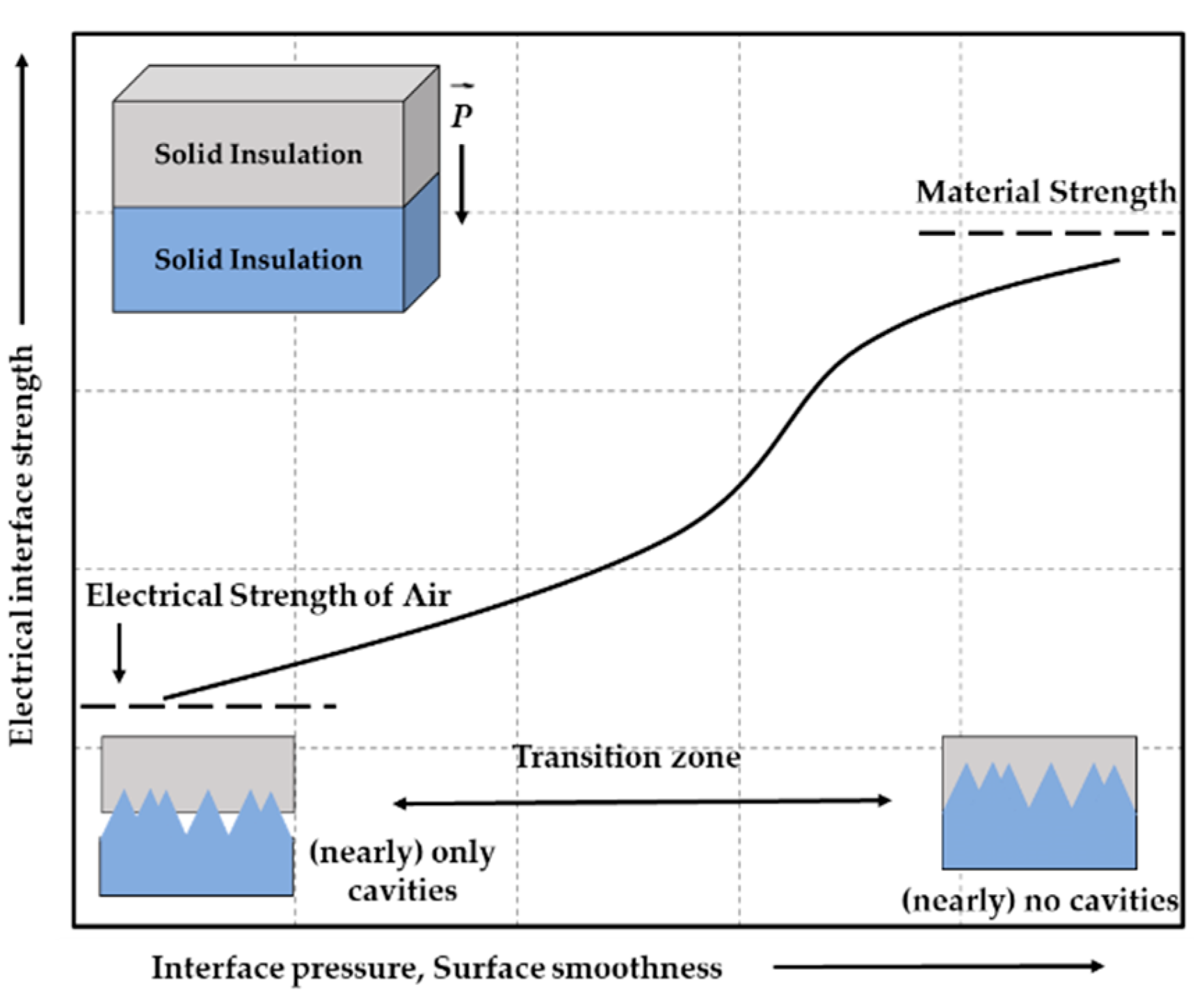
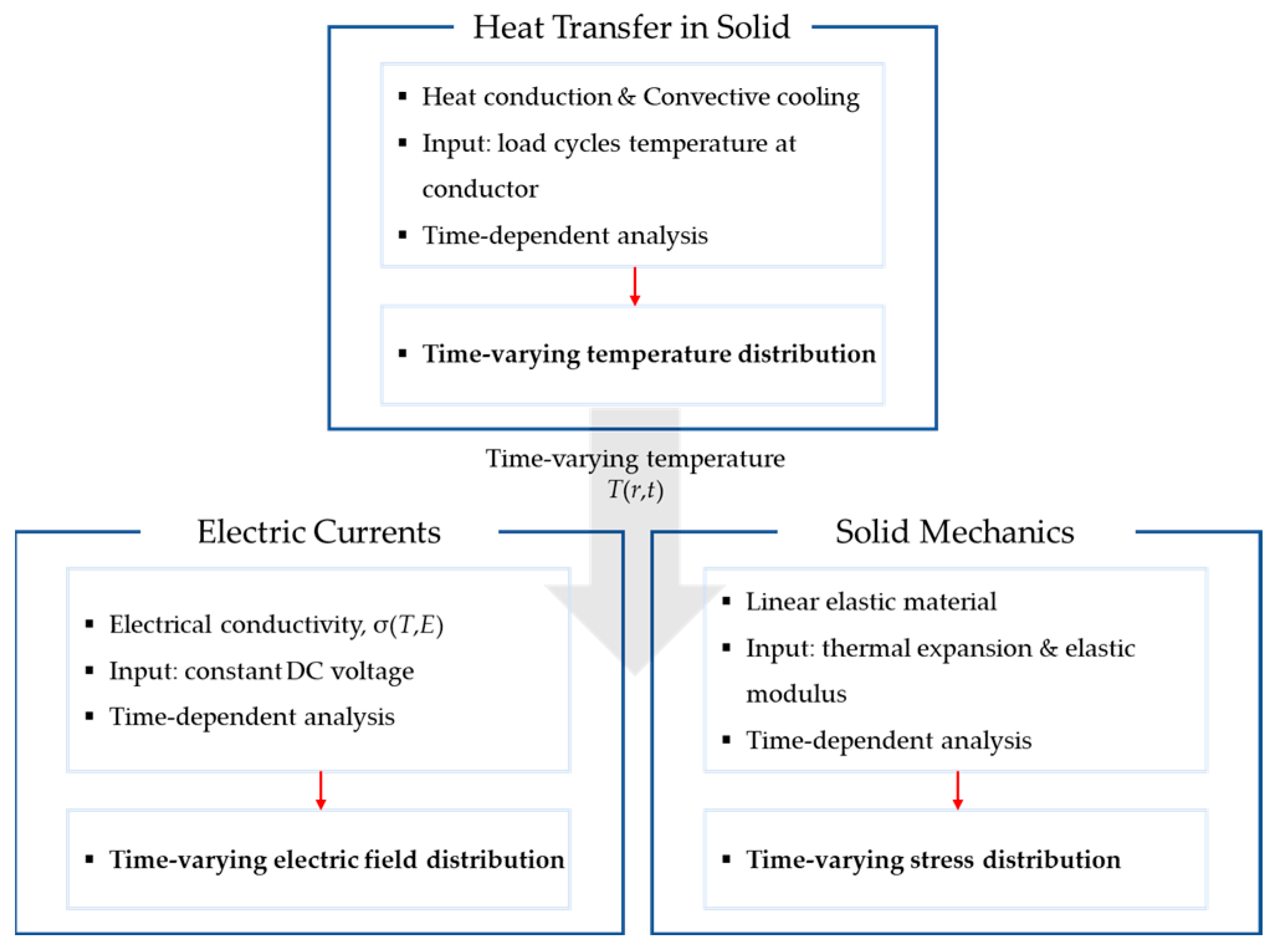
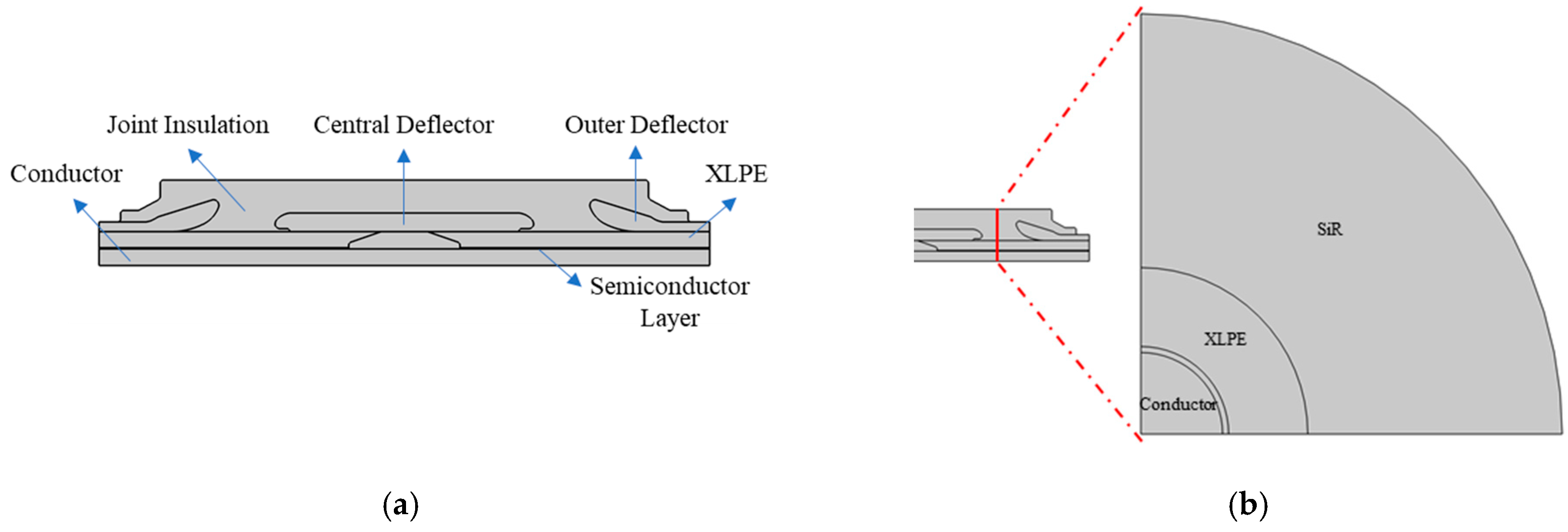

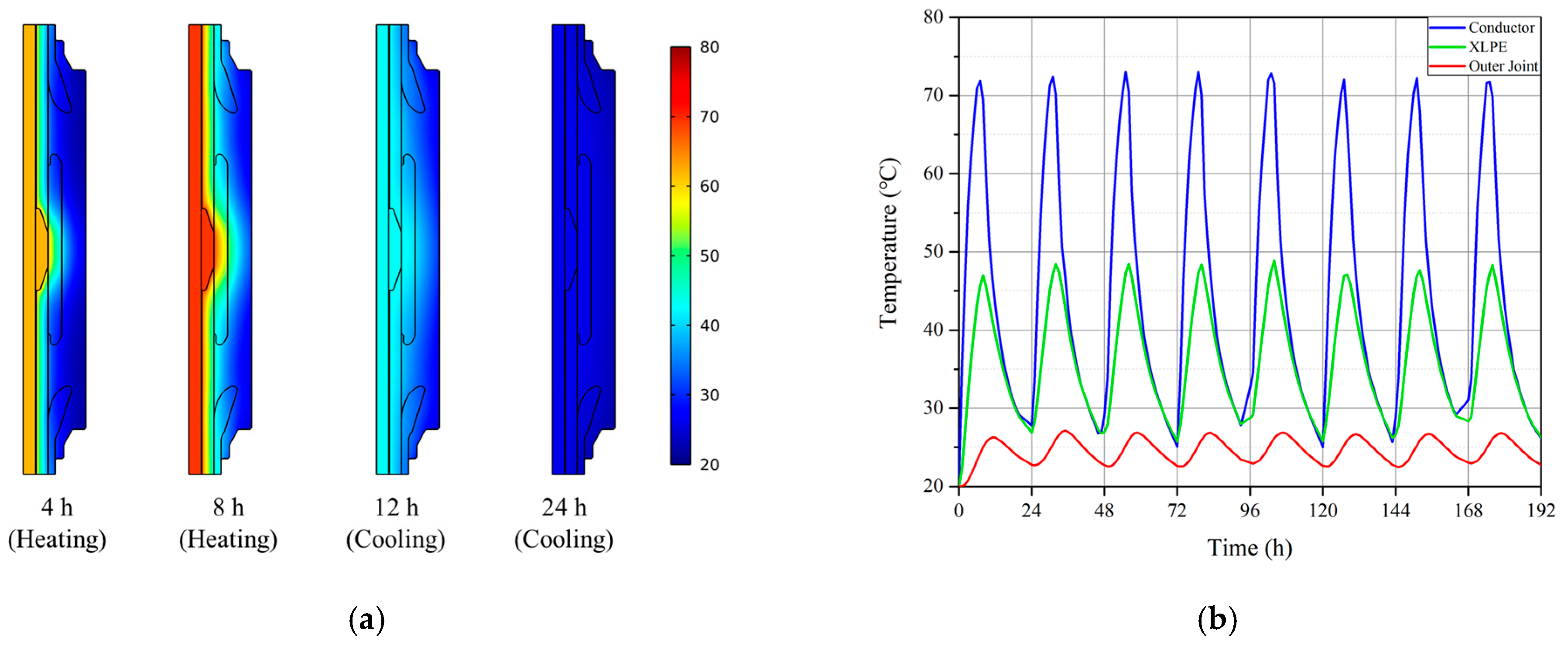
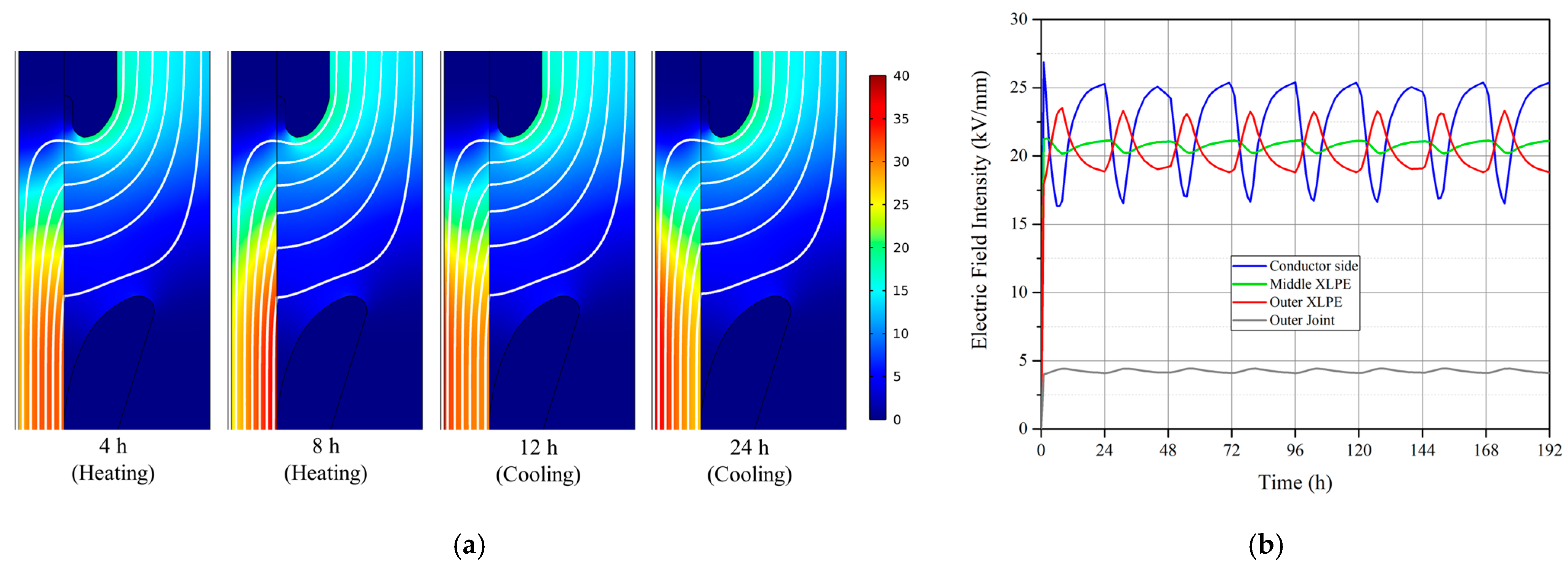
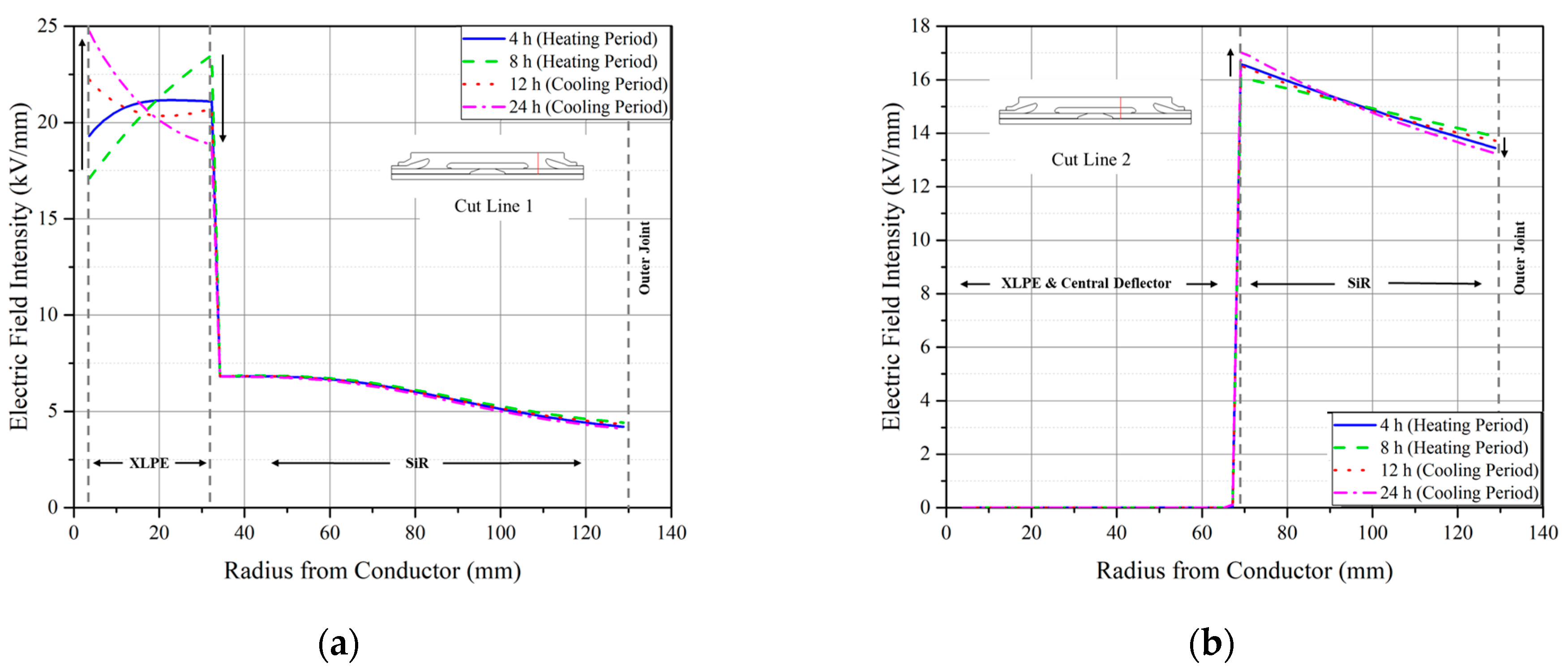
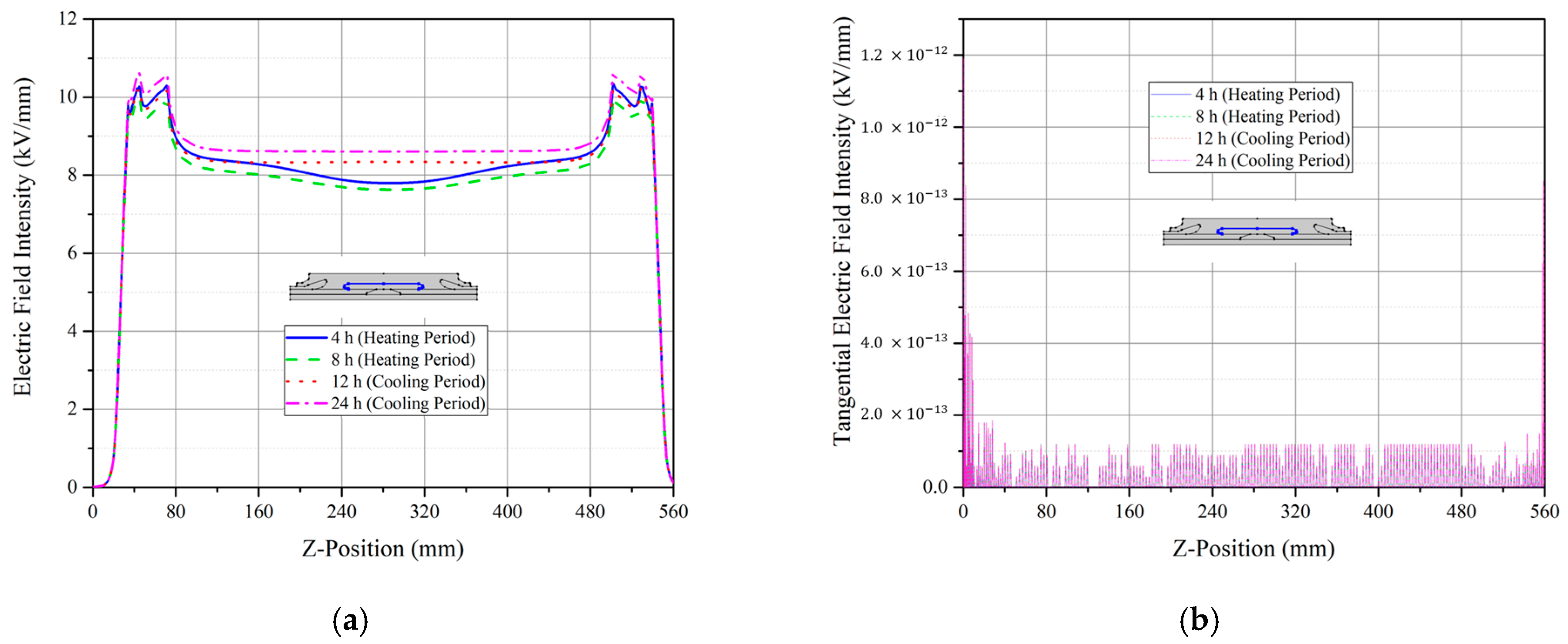
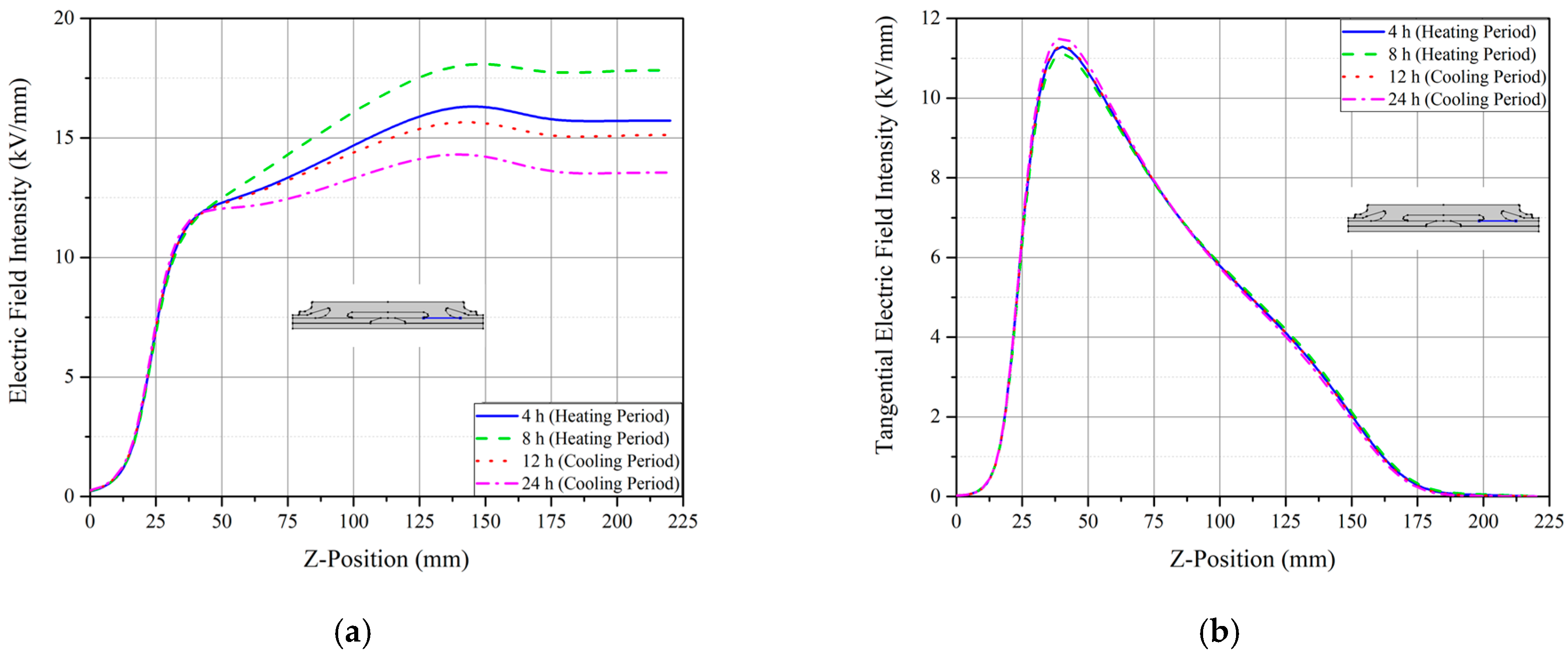
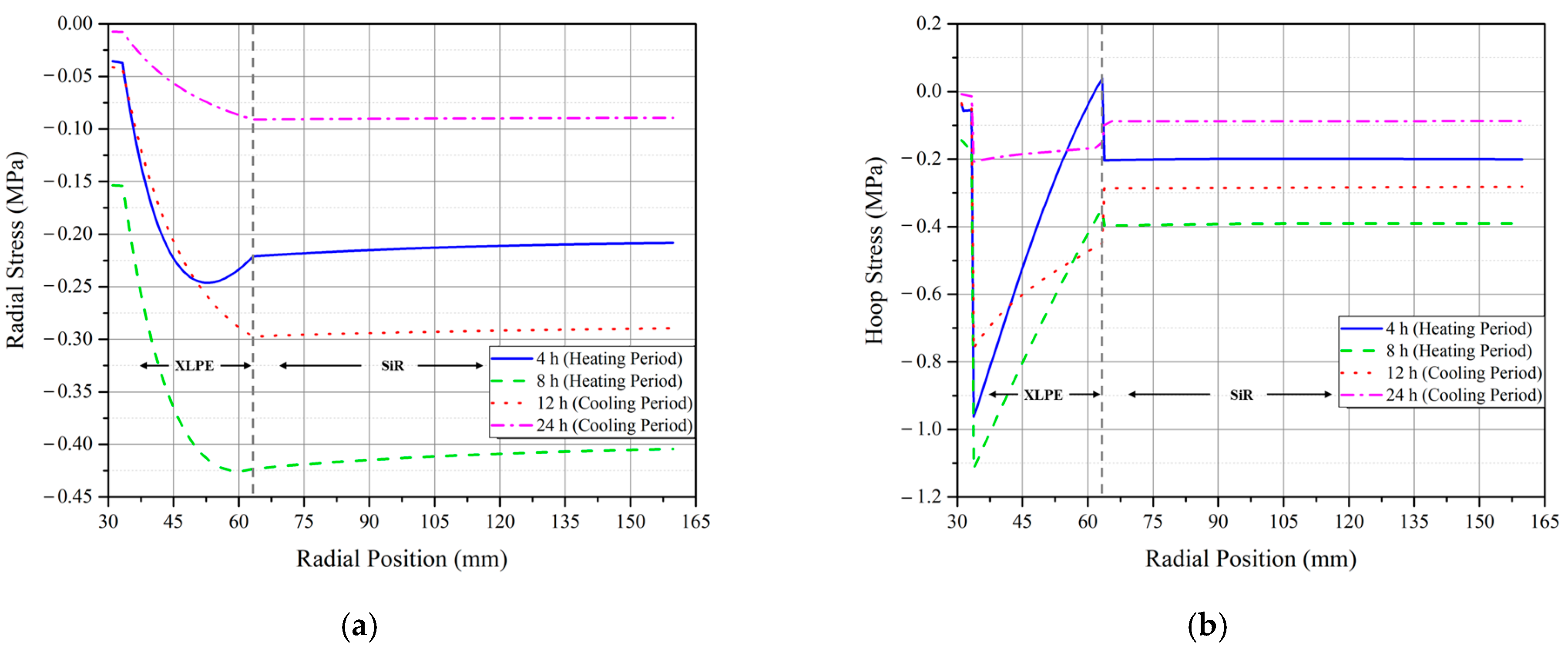
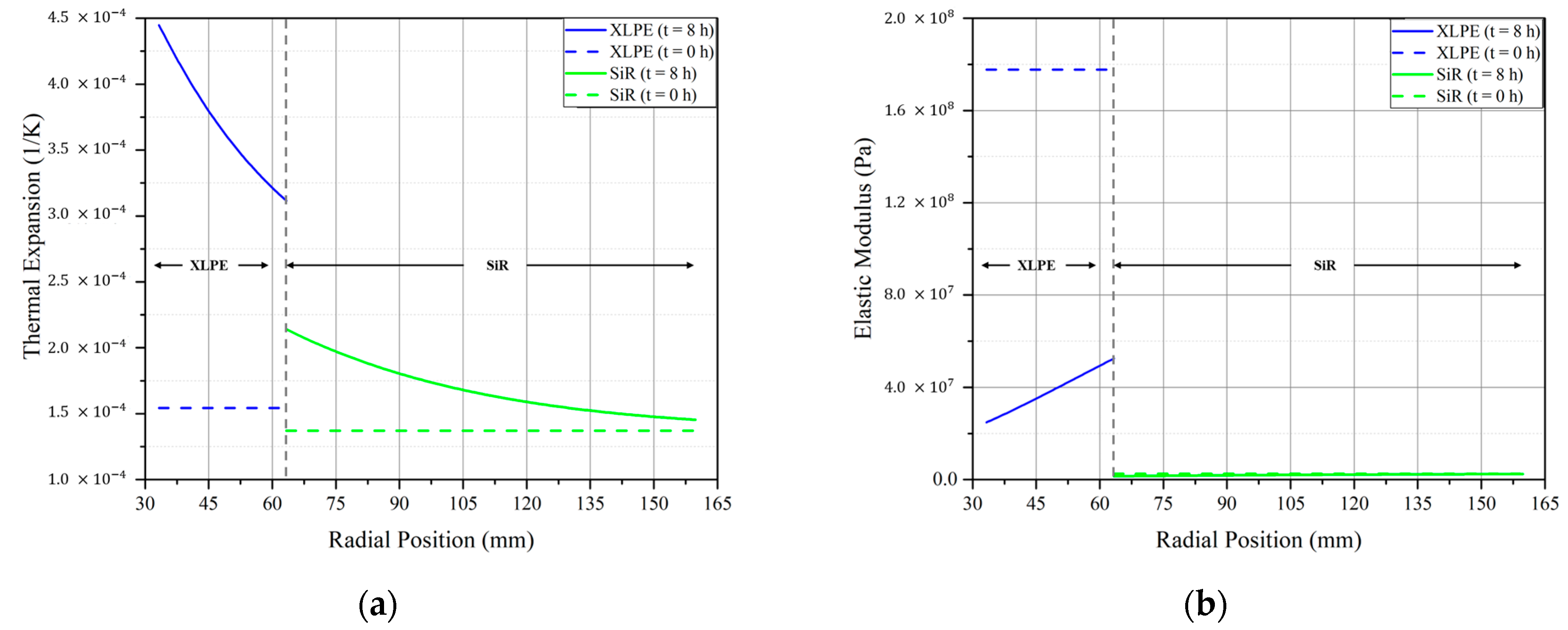

| Parameter | XLPE | SiR |
|---|---|---|
| Temperature dependent coefficient α (1/K) | 0.05 | 0.01672 |
| Electric field dependent coefficient β (mm/kV) | 0.03 | 0.04719 |
| Relative permittivity Ɛr | 2.3 | 3.3 |
| Reference electrical conductivity σ0 (S/m) | 3 × 10−16 | 2.2 × 10−13 |
| Reference temperature T0 (K) | 298.15 | 298.15 |
| Reference electric field E0 (kV/mm) | 10 | 10 |
| Thermal conductivity k (W/(m∙K)) | 0.286 | 0.29 |
| Heat transfer coefficient h (W/(m2∙K)) | 5 | |
| Ambient temperature Tamb (K) | 293.15 | |
| Parameters | XLPE | SiR | Copper |
|---|---|---|---|
| Elastic modulus (Pa) | |||
| Thermal expansion (1/K) | |||
| Poisson’s ratio | 0.46 | 0.49 | 0.34 |
| Location in Cable Joints | Et = 8 h (kV/mm) | Et = 24 h (kV/mm) | Field Strength Change | |
|---|---|---|---|---|
| Cut Line 1 | Inner Semicon/XLPE | 17.10 | 24.75 | 44% increase |
| XLPE/SiR | 23.50 | 18.86 | 20% decrease | |
| Cut Line 2 | Central Deflector/SiR | 16.10 | 17.08 | 6% increase |
| SiR/Outer Joint | 13.88 | 13.25 | 5% decrease | |
| Deflector/SiR | End of Deflector | 9.9 | 10.60 | 7% increase |
| Middle of the Deflector | 7.64 | 8.60 | 12% increase | |
| XLPE/SiR | z-axis, 148 mm | 18.10 | 14.30 | 11% decrease |
| Varying Temperature Range | Diameter of Conductor | Interfacial Pressure Increment | |
|---|---|---|---|
| Experimental Results [38] | 24~60 °C | Approx. 13 mm | Max. 0.306 MPa Average. 0.257 MPa |
| Simulation Results | 20~73 °C (First cycle) | 62 mm | 0.420 MPa |
Publisher’s Note: MDPI stays neutral with regard to jurisdictional claims in published maps and institutional affiliations. |
© 2022 by the authors. Licensee MDPI, Basel, Switzerland. This article is an open access article distributed under the terms and conditions of the Creative Commons Attribution (CC BY) license (https://creativecommons.org/licenses/by/4.0/).
Share and Cite
Kim, S.-J.; Lee, D.-G.; Kim, J.-H.; Lee, B.-W. Numerical Analysis of Electric Field Characteristics and Interfacial Pressure of HVDC XLPE Cable Joint Considering Load Cycles. Energies 2022, 15, 4684. https://doi.org/10.3390/en15134684
Kim S-J, Lee D-G, Kim J-H, Lee B-W. Numerical Analysis of Electric Field Characteristics and Interfacial Pressure of HVDC XLPE Cable Joint Considering Load Cycles. Energies. 2022; 15(13):4684. https://doi.org/10.3390/en15134684
Chicago/Turabian StyleKim, Sun-Jin, Do-Gyu Lee, Jae-Hyung Kim, and Bang-Wook Lee. 2022. "Numerical Analysis of Electric Field Characteristics and Interfacial Pressure of HVDC XLPE Cable Joint Considering Load Cycles" Energies 15, no. 13: 4684. https://doi.org/10.3390/en15134684
APA StyleKim, S.-J., Lee, D.-G., Kim, J.-H., & Lee, B.-W. (2022). Numerical Analysis of Electric Field Characteristics and Interfacial Pressure of HVDC XLPE Cable Joint Considering Load Cycles. Energies, 15(13), 4684. https://doi.org/10.3390/en15134684






